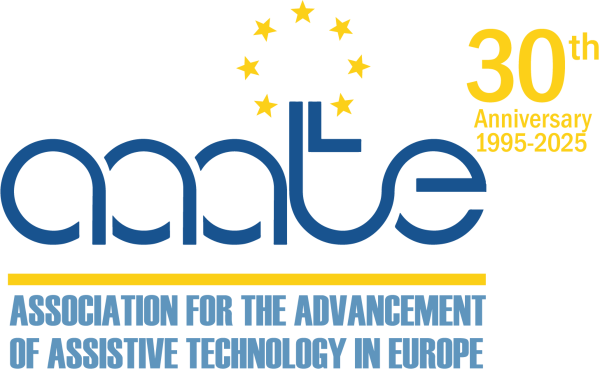ID: 326
/ IA We.M1: 1
Inclusion Forum
Keywords: N/A
Assistive Technology Challenge – Challenge-based, Hands-on Teaching at ETH Zurich
R. Gassert1,2
1Department of Health Sciences and Technology, ETH Zurich; 2Swiss national contact person of AAATE
Developing assistive technologies presents unique and multifaceted challenges beyond those of conventional technology development. It requires a deep understanding of users’ specific needs, the context in which a technology will be used, and the ability to design flexible, user-centered solutions that adapt to evolving requirements over time.
The Assistive Technology Challenge (ATC; https://relab.ethz.ch/education/assistive-
technology-challenge.html) is a hands-on, challenge-based course that introduces students from Health Sciences and Technology, Mechanical Engineering, and Biomedical Engineering at ETH Zurich to the interdisciplinary field of assistive technology. Through this course, students develop technical, social, and methodological competencies while engaging in a real-world co-design process.
In teams of four, students — with and without engineering backgrounds — collaborate closely with a person with a physical disability (the challenger), who defines a specific, real-world challenge they face in daily life. Working together with the challenger (and caregivers where appropriate), each team designs, prototypes, and evaluates a personalized technical solution aimed at addressing that challenge. The goal is to deliver a functional and meaningful solution that the challenger can keep and use beyond the course.
The ATC offers students an exceptional learning opportunity to:
- Apply engineering and project management tools in a human-centered design process.
- Gain experience with inclusive design and interdisciplinary teamwork.
- Contribute to a project with tangible, immediate social impact.
By addressing real needs with real users, students not only advance their technical andcollaborative skills, but also develop a deeper understanding of empathy, responsibility, andthe societal relevance of engineering — preparing them to create more inclusivetechnologies in their future careers.
ID: 318
/ IA We.M1: 2
Inclusion Forum
Keywords: N/A
Lowering Digital Barriers: A Project to Raise Public Awareness about the Potential of Assistive Technology
J. Daems, W. de Backer
Thomas More University of Applied Sciences, Belgium
Historically, assistive technologies have been expensive and exclusive to people with disabilities. However, assistive technologies are becoming more mainstream and commonly used applications such as translation and text simplification can provide greater access for all. Technologies such as text-to-speech, magnification, word prediction, … are becoming interesting options for everyone through built-in accessibility settings, web services and free or low-cost applications. As a result, these technological innovations can lower even more digital barriers. This will benefit not only people with disabilities, but also those with low literacy levels, language barriers, older people or those who find digital technology overwhelming or complex.
At the same time, all these tools remain largely unknown to a wide audience.
In this project, we developed ten practical guides addressing ten specific, everyday digital barriers. To do this, we selected ten tools based on a widespread survey of the main needs of people who experience digital barriers. The solutions elaborated in the manuals are therefore not exclusively assistive technologies but also more mainstream technologies such as password management. After the selection, we developed a prototype of the manuals, on which we asked for feedback from professionals and digital support volunteers (=“digihelpers”) from different contexts and backgrounds in four co-creation sessions in four different locations in Flanders. After processing the feedback, we presented the manuals again to a group of stakeholders (digihelpers and help-seekers) and then finalised the manuals. In this way we were able to tailor the content and the form of the manuals (structure, language, symbols, images) to a broad group of end-users.
The dissemination of the project is supported by numerous organizations across Flanders that are actively working towards digital inclusion. Through this network, we provide thousands of digihelpers (professionals and digital support volunteers) with a hands-on introduction to existing solutions to digital barriers while simultaneously increasing overall public awareness of these solutions. During one of the co-creation sessions, a participant came up with the tagline “encouraging the search for solutions”.
ID: 321
/ IA We.M1: 3
Inclusion Forum
Keywords: N/A
Life Saving Assistive Technology: SENTRYNet for the Deaf and Hard of Hearing
J. McDonald
Sheffield Hallam University, United Kingdom
SENTRYNet is a prototype smart home solution designed to support Deaf and Hard of Hearing individuals by providing privacy-preserving, multi sensory alerts for emergencies, environmental awareness, and situational awareness. The system integrates wearable technology (a standard Samsung Galaxy Watch), motion sensors, environmental detection, and pillow vibrating actuators. Alerts are delivered discreetly via vibration and visual cues, avoiding over-redliance on smart phones.
Designed with the deaf community, SENTRYNet addresses communication barriers, eases access to emergency services and interactions within the home, supporting independent, safe living, while respecting users’ privacy. The customisable user interface incorporates British Sign Language iconography, laying the groundwork for culturally aware accessibility design.
ID: 332
/ IA We.M1: 4
Inclusion Forum
Keywords: N/A
Harnessing 3D Printing for Providing Accessible Assistive Technology
Z. Khan
Assistive Technology Products and Services, Health Sciences Centre Winnipeg, Canada
Funding for assistive technology is still unattainable for many within the healthcare system in Canada, with funding sources being limited through Government or Public health sources and with very few private sources available. Due to this specialty aids for Activities of Daily Living are becoming cost-prohibitive for many client populations in our service area.
Meanwhile, 3D printing and the use of 3D design is a technology that is rapidly growing in profile. Many people in different industries are applying the technology in innovative ways.
As a specialty healthcare service with a mandate to help our clients achieve as much independence as possible, but with a very limited capacity for laborious fabrication, we wanted an innovative way to provide solutions to more clients with less drain on our physical resources. In our Occupational Therapist led Assistive Technology program, 3D printing and 3D design is being harnessed to develop low cost, customised assistive technology to increase the accessibility to Assistive technology devices for our clients.
|
